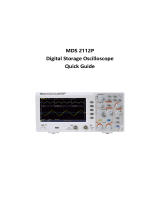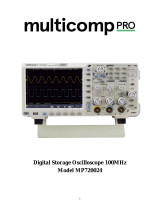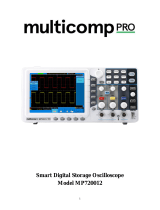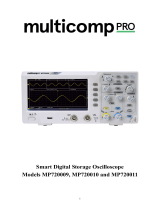Page is loading ...

OL-612
PORTABLE MIXED SIGNAL DIGITAL
STORAGE OSCILLOSCOPE
Version Date Software Version
1.0 October 2014 4.2
- 0 MI2012 -

September 2014
SAFETY RULES
* The safety can turn compromised if there are not applied the instructions
given in this Manual.
* Use the equipment only on systems or devices to measure the negative connected
to ground potential or off-grid.
* This is a class I equipment, for safety reasons plug it to a supply line with the
corresponding ground terminal.
* This equipment can be used in Over-Voltage Category II installations and
Pollution Degree 1 environments (see 2.3.-).
* When using some of the following accessories use only the specified ones to
ensure safety:
Power cord
Probes
* Observe all specified ratings both of supply and measurement.
* Remember that voltages higher than 70V DC or 33V AC rms are dangerous.
* Use this instrument under the specified environmental conditions.
* The user is only authorized to carry out the following maintenance operations:
Replace the mains fuse of the specified type and value.
On the Maintenance paragraph the proper instructions are given.
Any other change on the equipment should be carried out by qualified
personnel.
* The negative of measure is at ground potential.
* Do not obstruct the ventilation system.
* Follow the cleaning instructions described in the Maintenance paragraph.

October 2014
* Symbols related with safety:
Specific Precautions
Radio interference
ATTENTION
This is a product of class A. In a
domestic environment can
produce radio interference, in which case the user should take
appropriate measures.
Descriptive Examples of Over-Voltage Categories
Cat I Low voltage installations isolated from the mains.
Cat II Portable domestic installations.
Cat III Fixed domestic installations.
Cat IV Industrial installations.

October 2014
TABLE OF CONTENTS
1 INTRODUCTION........................................................................................... 1
1.1 General Characteristics
....................................................................... 1
2 JUNIOR US
ER GUIDEBOOK............................................................................ 2
2.1
Introduction
to the Front Panel and the User's Interface.......................... 2
2.1.1 Front Panel
................................................................................... 3
2.1.2 Rear Panel
.................................................................................... 4
2.1.3
Control (key and knob) Area
........................................................... 5
2.2 Digital Storage Oscilloscope
................................................................ 7
2.2.1
User Interface Introduction
............................................................. 7
2.2.2 How to
Implement the General Inspection......................................... 9
2.2.3 How
to
Implement the Function Inspection.......................................10
2.2.4 How to
Implement the Probe Compensation .....................................11
2.2.5
How
to Set the Probe Attenuation Coefficient ....................................12
2.2.6 How to
Use the Probe Safely ..........................................................12
2.2.7
How to
Implement Auto-calibration .................................................13
2.2.8 Introduction
to the Vertical System .................................................13
2.2.9
Introduction to
the Horizontal System..............................................15
2.2.10 Introdu
ction to the Trigger System..................................................16
2.3 Logic Analyzer
..................................................................................17
2.3.1 LA
input
connection.......................................................................17
2.3.2 User interface
introduction .............................................................17
2.3.3
How
to acquire data ......................................................................18
2.3.4 How to
observe and analyze the data ..............................................19
2.3.5 Display
systems
............................................................................19
2.3.6 Trigger system
.............................................................................21
2.3.7
Threshold voltage system
..............................................................22
2.3.8 Sampling system
..........................................................................23
3 ADVANCE
D USE
R GUIDEBOOK......................................................................25
3.1 Digital Storage Oscilloscope
...............................................................26
3.1.1 How to
Set the Vertical System.......................................................26
3.1.2 Implementation
of
Mathematical Manipulation Function ......................31
3.1.3 Using FFT
function ........................................................................33
3.2 Use
VERTICAL POSITION and VOLTS/DIV Knobs ...................................38
3.3
How to
Set the Trigger System...........................................................42
3.3.1 Single Trigger
...............................................................................43
3.3.2 Alternate
T
rigger ..........................................................................49
3.4 How
to Operate the Function Menu .....................................................55
3.4.1
How to
Implement Sampling Setup .................................................55
3.4.2 How to
Set the Display System .......................................................57
3.5
How to
Save and Recall a Waveform ...................................................61
3.5.1 How to
Implement the Auxiliary System Function Setting ...................64
3.5.2 How
to
Implement the Automatic Measurement ................................66

October 2014
3.5.3 How to Implement the Cursor Measurement .....................................69
3.5.3.1
The Cursor Measurement for normal model
...................................70
3.5.3.2 The Cursor Measurement for FFT
model ........................................72
3.5.4
How to
Use Autoscale....................................................................75
3.5.5 How to
Use Executive Buttons ........................................................77
3.6 Logic
Analyzer
..................................................................................78
3.6.1 How to
set sampling system...........................................................78
3.6.2 How to
set trigger system ..............................................................80
3.6.3
How to
set threshold .....................................................................91
3.6.4 How to
set display system..............................................................93
3.6.5
How to
set BUS ............................................................................95
3.6.6 How to
measure ...........................................................................96
3.6.7
How to
save and recall ..................................................................97
3.6.8 How to use USB
flash disk to storage...............................................99
3.6.9 How
to
search ..............................................................................99
3.6.10 How
to review setting info............................................................ 103
3.6.11
How to use cursor measurement
...................................................103
3.6.12 How to
set Utility ........................................................................ 106
4 DEMONST
R
ATION .....................................................................................107
4.1 Example
1: Measurement a Simple Signal..........................................107
4.2 Example
2: Working out the Gain of the Amplifier in the Metering Circuit 108
4.3
Example
3: Capture the Single Signal................................................ 109
4.4 Example
4: Analyze the Details of a Signal.........................................111
4.5 Example 5:
Examine the Phase shift between two related signals .......... 113
4.6
Example 6:
Video Signal Trigger .......................................................114
5 TROUBLES
HOOTING.................................................................................. 115
6 SPECIFIC
ATIONS ......................................................................................117
7 MAINTENANCE .........................................................................................121
7.1 General
Care
..................................................................................121
7.2 Cleaning........................................................................................ 121
8 BATTERY
USING GU
IDE ............................................................................. 122
8.1 Charging the oscilloscope
................................................................. 122
8.2 Replacing
the Lithium Battery Unit .................................................... 122

October 2014 Page 1
PORTABLE MIXED SIGNAL DIGITAL STORAGE
OSCILLOSCOPE
OL-612
1 INTRODUCTION
1.1
General Characteristics
► Digital Storage Oscilloscope
Bandwidth 100 MHz;
Sample rate 2 GS/s half channel
1
, 1 GS/s each channel;
Dual channel, 2 M points on each channel for the Record length;
Reading-out with the cursor;
Twenty automatic measurement functions;
Autoscale function;
Color liquid crystal display of high resolution and high contrast with
adjustable back light;
Storage and call-out of waveforms;
Automatic setting function provided capable of fast setting;
Multiple-waveform calculation function;
Built-in FFT function;
Implementation of detecting the average and peak values of the
waveform;
Digital real-time oscilloscope;
Edge, video, alternate, pulse and slope triggering function;
RS232 or USB communication ports;
Different continuous displaying time;
Multiple language User Interface.
► Logic Analyzer
16 input channel;
4M max Storage for each channel;
Plenty of trigger Mode;
Convenient data measurement & data search;
Freely setting of all kinds of threshold level.
1
Half channel is when only one channel is turned on.

Page 2 October 2014
2 JUNIOR USER GUIDEBOOK
This chapter deals with the following topics mainly:
► Digital Storage Oscilloscope
Introduction to the front panel and the user's interface of the series
oscilloscope.
How to implement the general inspection.
How to implement the function inspection.
How to make a probe compensation.
How to set the probe attenuation coefficient.
How to use the probe safely.
How to implement an auto-calibration.
Introduction to the vertical system.
Introduction to the horizontal system.
Introduction to the trigger system.
► Logic Analyzer
User interface introduction.
How to acquire data.
How to observe and analyze the data.
Trigger system.
Threshold voltage system.
Sampling system.
2.1
Introduction to the Front Panel and the User's Interface
When you get a new-type oscilloscope, you should get acquainted with its front
panel at first and the OL-612 mixed digital storage oscilloscope is no exception.
This chapter makes a simple description of the operation and function of the
front panel of the OL-612 mixed oscilloscope, enabling you to be familiar with
the use of the OL-612 mixed oscilloscope in the shortest time. The OL-612
mixed oscilloscope offers a simple front panel with distinct functions to users for
their completing some basic operations, in which the knobs and function
pushbuttons are included. The knobs have the functions similar to other
oscilloscopes. The 5 buttons in the column on the right side of the display screen
are menu selection buttons (defined as F1 to F5 from top to bottom
respectively), through which, you can set the different options for the current
menu. The other pushbuttons are function buttons, through which, you can enter
different function menus or obtain a specific function application directly.

Page 4 October 2014
2.1.2
Rear Panel
Figure 2. Rear Panel.
USB Host port: It is used to transfer data when external USB equipment
connects to the oscilloscope regarded as "host device". For example:
upgrading software by USB flash disk needs to use this port.
Ground connection.
VGA port: To connect the oscilloscope with external equipment as serial
port, or to connect the oscilloscope with a monitor or a projector as VGA
output.
Handle.
AC power input jack.

October 2014 Page 5
2.1.3
Control (key and knob) Area
Figure 3. Keys Overview.
Switch.
Switch includes two keys and one knob. Press "OSC/LA" to switch between
DSO and LA.
For DSO "cursor" knob and "info" key are idle. But the "cursor" knob
takes effect in magnifying or minificating the waveform after FFT
operation when the mode is FFT.
For LA, "cursor" knob to adjust current cursor position and "info" key
to loading setting info for acquired waveform and current waveform.
Function key area.
For DSO 0~5 keys are idle and 6~F refer to different DSO function
menu.
For LA, 3.4.5.6.7 refers to figure and other keys refer to digit or
function menu.
Trigger control area with 4 keys and 1 knob.
For DSO, "Trig adjust" knob is to adjust trigger voltage. Other four
keys refer to trigger system setting.
For LA, "Force trig" key is idle. "Trig menu" refer to trigger menu
control. "Trig adjust" knob to adjust trigger position in memory, "SET
50%" is to set trigger position as 50% and "SET Zero" set trigger
position as 0.

Page 6 October 2014
Horizontal control area with 2 knob and 1 key.
For DSO, "Horizontal position" knob control trigger position,
"Volts/Div" control time base, "Horizontal menu" key refer to
horizontal system setting menu.
For LA, "Horizontal menu" key is idle. "Horizontal position" knob to
adjust the position of value displayed currently quickly. "Sec/Div" knob
to adjust value resolution displayed currently.
Vertical control area. It's including 3 keys and 4 knobs.
For DSO: "CH1 menu" and "CH2 menu" correspond to setting menu in
CH1 and CH2, "Wave Math" key refer to math menu, the math menu
consists of six kinds of operations, including CH1-CH2, CH2-CH1,
CH1+CH2, CH1*CH2, CH1/CH2 and FFT .Two "Vertical position" knobs
control the vertical position of CH1. CH2, and two "Volts/Div" knob
control voltage scale of CH1, CH2.
For LA, "CH1 menu", "CH2 menu", "Wave math" keys and "CH2
Volts/Div" knob are idle. "CH1 Vertical", "CH2 Vertical" to adjust the
M1, M2 position in Cursor menu when cursor display is on "CH1
Volts/Div".
Menu option setting: F1~F5.

October 2014 Page 7
2.2
Digital Storage Oscilloscope
2.2.1
User Interface Introduction
Figure 4. Illustrative Drawing of Display Interfaces.
The trigger state indicates the following information:
Auto: The oscilloscope is under the Automatic mode and is collecting the
waveform under the non-trigger state.
Trig’d: The oscilloscope has already detected a trigger signal and is
collecting the after-triggering information.
Ready: All pre-triggered data have been captured and the oscilloscope
has been already ready for accepting a trigger.
Scan: The oscilloscope captures and displays the waveform data
continuously in the scan mode.
Stop: The oscilloscope has already stopped the waveform data
acquisition.
Waveform Viewing Area.

Page 8 October 2014
The purple pointer indicates the horizontal trigger position, which can be
adjusted by the horizontal position control knob.
The pointer indicates the trigger position in the internal memory.
This reading shows the time deviation between the horizontal trigger
position and the window centre line, which is regarded as 0 in the window
center.
It indicates the current function menu.
It indicates the operation options for the current function menu, which
changes with the function menus.
The purple pointer shows the trigger level position.
The reading shows the frequency of the two channels. It is a 6 digits
cymometer. Its measurement range of frequency is 2Hz to full bandwidth.
When the triggering mode is edge triggering, it is a one channel
cymometer and it can only measure the frequency of the triggering
channel. When the triggering mode is alternating triggering, it is a two
channel cymometer and it can measure the frequency of two channels.
The reading shows the trigger level value.
The reading shows the trigger source.
It shows the selected trigger type:
Rising edge triggering.
Falling edge triggering.
Video line synchronous triggering.
Video field synchronous triggering.
The reading shows the window time base set value.
The reading shows the main time base set value.
The two yellow dotted lines indicate the size of the viewing expanded
window.
The icon shows the coupling mode of the CH2 channel.
"—" indicates direct current coupling.
"
∼" indicates AC coupling.
"
" indicates GND coupling.
The reading shows the vertical scale factor (the Voltage Division) of the
CH2 channel.

October 2014 Page 9
The icon indicates the coupling mode of the CH1 channel:
The icon "–" indicates the direct current coupling.
The icon "
∼" indicates the AC coupling.
The icon "
" indicates GND coupling.
The reading indicates the vertical scale factor (the Voltage Division) of the
CH1 channel.
The information shows the zero point positions of CH1 or CH2 channel.
The yellow pointer shows the grounding datum point (zero point position)
of the waveform of the CH2 channel. If the pointer is not displayed, it
shows that this channel is not opened.
The red pointer indicates the grounding datum point (zero point position)
of the waveform of the CH1 channel. If the pointer is not displayed, it
shows that the channel is not opened.
The positions of two purple dotted line cursors measurements.
2.2.2
How to Implement the General Inspection
After you get a new oscilloscope, it is recommended that you should make a
check on the instrument according to the following steps:
► Check whether there is any damage caused by transportation.
If it is found that the packaging carton or the foamed plastic protection
cushion has suffered serious damage, do not throw it away first till the
complete device and its accessories succeed in the electrical and mechanical
property tests.
► Check the Accessories
The supplied accessories have been already described in the "Appendix A:
Enclosure" of this Manual. You can check whether there is any loss of
accessories with reference to this description. If it is found that there is any
accessory lost or damaged, please get in touch with the distributor of
PROMAX responsible for this service or the PROMAX local offices.
► Check the Complete Instrument
If it is found that there is damage to the appearance of the instrument, or
the instrument can not work normally, or fails in the performance test,
please get in touch with the PROMAX distributor responsible for this
business or the PROMAX local offices. If there is damage to the instrument
caused by the transportation, please keep the package. With the
transportation department or the PROMAX distributor responsible for this
business informed about it, a repairing or replacement of the instrument will
be arranged by the PROMAX.

Page 10 October 2014
2.2.3
How to Implement the Function Inspection
Make a fast function check to verify the normal operation of the instrument,
according to the following steps:
Connect the Instrument to the Power and Push down the Power
Switch Button.
The instrument carries out all self-check items and shows the prompt
"Press any Key Enter system". Press the "8 (UTILITY)" button to get
access to the "FUNCTION" menu and push down F2 the menu selection
button to call out the function "Recall Factory". The default attenuation
coefficient set value of the probe in the menu is 10X.
Set the Switch in the Oscilloscope Probe as 10X and Connect the
Oscilloscope with CH1 Channel.
Align the slot in the probe with the plug in the CH1 connector BNC, and then
tighten the probe with rotating it to the right side.
Connect the probe tip and the ground clamp to the connector of the probe
compensator.
Press the "7(AUTOSET)" Button.
The square wave of 1 KHz frequency and 5V peak-peak value will be
displayed in several seconds (see Fig. 4).
Figure 5. Auto set.
Check CH2 by repeating Step 2 and Step 3.

October 2014 Page 11
2.2.4
How to Implement the Probe Compensation
When connect the probe with any input channel for the first time, make this
adjustment to match the probe with the input channel. The probe which is not
compensated or presents a compensation deviation will result in the measuring
error or mistake. For adjusting the probe compensation, please carry out the
following steps:
Set the attenuation coefficient of the probe in the menu as 10X and that
of the switch in the probe as 10X, and connect the oscilloscope probe
with the CH1 channel. If a probe hook tip is used, ensure that it keeps in
close touch with the probe. Connect the probe tip with the signal
connector of the probe compensator and connect the reference wire
clamp with the ground wire connector of the probe connector, and then
press the button "7(AUTOSET)".
Check the displayed waveforms and regulate the probe till a correct
compensation is achieved (see Figure 5 and Figure 6).
Figure 6. Displayed Waveforms of the Probe Compensation.
Repeat the steps mentioned if needed.
Figure 7. Adjust Probe.

Page 12 October 2014
2.2.5
How to Set the Probe Attenuation Coefficient
The probe has several attenuation coefficients, which will influence the vertical
scale factor of the oscilloscope.
If it is required to change (check) the set value of the probe attenuation
coefficient, press the function menu button of the channels used, then push down
the selection button corresponding to the probe till the correct set value is
shown.
This setting will be valid all the time before it is changed again.
NOTE: The attenuation coefficient of the probe in the menu is preset to 10X
when the oscilloscope is delivered from the factory.
Make sure that the set value of the attenuation switch in the probe is the same
as the menu selection of the probe in the oscilloscope.
The set values of the probe switch are 1X and 10X (see Figure 7).
Figure 8. Attenuation Switch.
NOTE: When the attenuation switch is set to 1X, the probe will limit the
bandwidth of the oscilloscope in 5MHz. If it is needed to use the
whole bandwidth of the oscilloscope, the switch must be set to 10X.
2.2.6
How to Use the Probe Safely
The safety guard ring around the probe body protects your finger against the
electric shock, shown as Figure 8.
Figure 9. Finger Guard.

October 2014 Page 13
CAUTION: In order to avoid suffering from the electric shock, please keep your
finger behind the safety guard ring of the probe body during the
operation. In order to protect you from suffering from the electric shock
during your using the probe, do not touch the metal part of the probe tip
when the probe is connected to the power supply. Before making any
measurements, please connect the probe to the instrument and connect
the ground terminal to the earth.
2.2.7
How to Implement Auto-calibration
The auto-calibration application can make the oscilloscope reach the optimum
condition rapidly to obtain the most accurate measurement value. You can carry
out this application program at any time, but when the range of variation of the
ambient temperature is up to or over 5 ºC, this program must be executed.
For the performing of the self-calibration, all probes or wires should be
disconnected with the input connector first. Then, press the "8(UTILITY)"
button to call out the FUNCTION menu; push down the F3 menu selection
button to choose the option " Do Self Cal"; finally, run the program after
confirming that everything is ready now.
2.2.8
Introduction to the Vertical System
Shown as Fig.10, there are a series of buttons and knobs in VERTICAL
CONTROLS. The following practices will gradually direct you to be familiar with
the using of the vertical setting.
Figure 10. Vertical Control Zone.

Page 14 October 2014
Use the button "VERTICAL POSITION" knob to show the signal in the
center of the waveform window. The "VERTICAL POSITION" knob
functions the regulating of the vertical display position of the signal.
Thus, when the "VERTICAL POSITION" knob is rotated, the pointer of
the earth datum point of the channel is directed to move up and down
following the wave form.
► Measuring Skill
If the channel is under the DC coupling mode, you can rapidly
measure the DC component of the signal through the observation of
the difference between the wave form and the signal ground.
If the channel is under the AC mode, the DC component would be
filtered out. This mode helps you display the AC component of the
signal with a higher sensitivity.
Change the Vertical Setting and Observe the Consequent State
Information Change.
With the information displayed in the status bar at the bottom of the
waveform window, you can determine any changes in the channel
vertical scale factor.
Rotate the vertical "VOLTS/DIV" knob and change the "Vertical Scale
Factor (Voltage Division)", it can be found that the scale factor of
the channel corresponding to the status bar has been changed
accordingly.
Press buttons of "CH1 MENU", "CH2 MENU" and "MATH MENU",
the operation menu, symbols, wave forms and scale factor status
information of the corresponding channel will be displayed in the
screen.

October 2014 Page 15
2.2.9
Introduction to the Horizontal System
Shown as Fig. 11, there are a button and two knobs in the "HORIZONTAL
CONTROLS". The following practices will gradually direct you to be familiar with
the setting of horizontal time base.
Figure 11. Horizontal Control Zone.
Use the horizontal "SEC/DIV" knob to change the horizontal time base
setting and observe the consequent status information change. Rotate
the horizontal "SEC/DIV" knob to change the horizontal time base, and
it can be found that the "Horizontal Time Base" display in the status
bar changes accordingly. The horizontal scanning speed steps from 2 ns
up to 100s in the sequence of 1-2-5.
Use the "HORIZONTAL POSITION" knob to adjust the horizontal
position of the signal in the waveform window. The "HORIZONTAL
POSITION" knob is used to control the triggering displacement of the
signal or for other special applications. If it is applied to triggering the
displacement, it can be observed that the wave form moves horizontally
with the knob when you rotate the "Horizontal Position" knob.
With the "HORIZONTAL MENU" button, you can do the Window Setting
and the Window Expansion.
/






